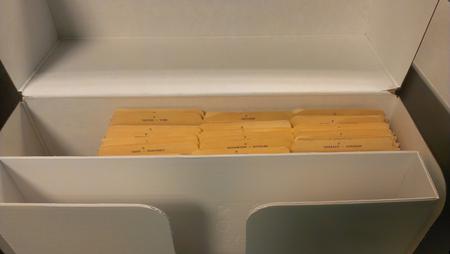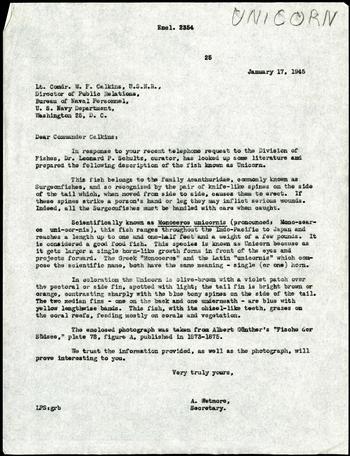
When I was little, I was fascinated with unicorns and thought they were one of the coolest mythical creatures around. So imagine my delight when I opened a box of correspondence from the Archive’s Accession 12-530 - National Museum of Natural History, Division of Fishes, Correspondence, 1973-1987 - and spotted a folder titled "U: Unicorn." With my curiosity instantly piqued, I had to know what was in that folder. To my surprise, the folder contained a 1945 letter from Smithsonian Secretary Alexander Wetmore to Lieutenant Commander W. F. Calkins of the United States Navy with information about a real, live, aquatic unicorn: the Unicorn fish, or Monoceros unicornis.
When people think of unicorns, their mind either wanders to the mythical creature of ancient lore, or narwhals (Monodon monoceros), which are often referred to as unicorns of the sea. However, the "real" unicorn of the sea is actually a member of the family Acanthuridae, which are commonly known as surgeon fishes because of the pair of sharp spines on their tails. They are native to the Pacific Ocean, especially Japan and the Hawaiian Islands. In Secretary Wetmore's letter, Dr. Leonard P. Schultz, curator of the Division of Fishes at the U.S. National Museum, noted that the unicorn is "considered a good food fish" and that sentiment is echoed in a 1901 preliminary report from the U.S. Commission of Fish and Fisheries detailing the fishing laws of Hawaii.

While Dr. Schultz provides a detailed description of the fish, my search for photographs of the Monoceros unicornis turned up empty. In fact, aside from Secretary Wetmore’s letter, I wasn’t able to find any reference to this particular species of fish after 1930. The Encyclopedia of Life has an image under the entry for Naso unicornis that matches Dr. Schultz’s description, but without knowing what happened to Monoceros unicornis it is hard to know if this is a new name for an old fish, or just a close relative. If you have any information on the whereabouts of this mysterious fish, please comment below. Alas, my search for the Unicorn continues!
Related Collections
- Accession 12-530 - National Museum of Natural History, Division of Fishes, Correspondence, 1973-1987, Smithsonian Institution Archives
Produced by the Smithsonian Institution Archives. For copyright questions, please see the Terms of Use.

Leave a Comment